Caddington Church Alterations and Repairs

The church from the south March 2012
There are detailed churchwardens’ accounts for Caddington from 1717 to 1836 [P35/5/1]. Horace Montagu Prescott, son of the vicar from 1862 to 1889, detailed these in his Notes on Caddington Church published in 1937 – there is a copy in the Bedfordshire and Luton Archives and Records Service Searchroom and some of the material below is taken from his work.
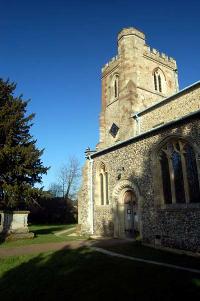
The west end of the church March 2007
The first entry in the churchwardens’ accounts regarding repairs to the church is in 1718 when John Rickson was paid 13/4 for “mendin windows and priming geats”. In the same year William Rickson was paid £2/16/8 “for ye church gates” and £4/15/8 for the fence to the churchyard. Two years later John Rickson was paid the large sum, for the day, of £10/15/- for, amongst other things, adding a small spire known as a Hertfordshire spike surmounted by a weathercock on top of the tower. The description reads: “for a spier to ye top of ye steeple, and a piece of oak 7 foot long, and ten foot of boarde for ye roof and gutters, and a ball to ye spier … and for 10 days work of myself and my men to ye church and ye steeple”. A new weathercock, costing 8/5 was set on this spire in 1720.
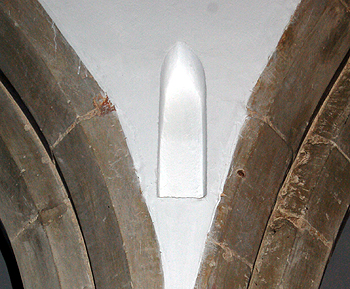
Niche in a spandrel in the north arcade June 2012
A lot of painting must have been carried out in 1763 as there is an account for “Skettlethorp, writing and painting”. He may have whitewashed the interior of the church and probably wrote extracts from scripture which, Prescott states, were in the sections between the spanrdels (gaps between the arches) in the arcades – he could remember the words “God loveth a cheerful giver”. The whitewash was removed in 1875. In the same year £16/3/5 was spent on glass.

The west tower showing different materials used in repairs June 2012
A bricklayer was paid £7/19/10 in 1772 and this was probably for repairs to the tower. Today the tower is a delightful hotch-potch of flint, stone and brick. In the same year another £9/14/5 was spent on glazier’s work.
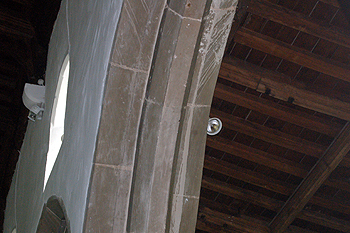
Chamfer on the south arcade June 2012
New lead was installed on the roof in 1792 at £1/5/8 per hundredweight – the whole job cost £11/17/10. Substantial repairs must have been undertaken in 1794 as a total of £29/5/5 was spent. In 1803 the tower was again repaired and in 1807 the huge sum of £57/3/4 was paid to Puddephatt the carpenter, Bateman the plumber and a man named Slow. Bateman received another £17/8/3 in 1808. He received another £38/4/9 for glazing in 1811.

Capital on the east side of the south door March 2012
During the first half of the 19th century some quite significant sums were disbursed, including £51/17/10 for roughcast plastering the church and the tower which, Prescott informs us, remained until 1928. In the period 1717 to 1837 a total of £1,302/13/11 was spent on the church in ever increasing amounts, Prescott did the following piece of analysis on expenditure:
- £128/11/9 between 1717 and 1745 (annual average £4/8/-);
- £226/8/7 between 1746 and 1785 (annual average £5/13/-);
- £297/3/11 between 1786 and 1807 (annual average £13/10/-);
- £650/9/8 between 1808 and 1837 (annual average £21/13/4).
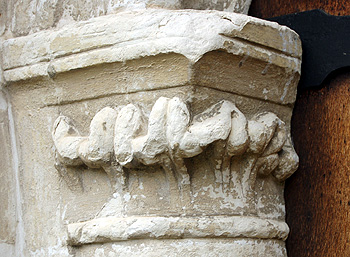
Capital on the west side of the south door March 2012
It is no wonder that less scrupulous or poorer parishes let their church get into a state of decay in these years. In 1822 the glebe terrier noted: “an ancient building but in thorough repair, containing in length fifty two feet, in breadth forty three feet”. Nevertheless, some of this work was of the sort which Prescott characterises as “penny wise pound foolish” and merely attacked the symptoms of decay not the root cause.
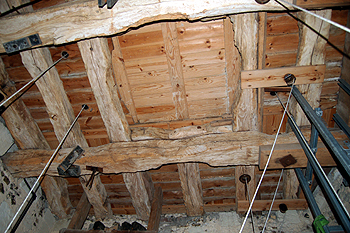
The roof of the clock chamber in the west tower June 2012
The bells were first mentioned in the will of Edward Dormer who died in 1523 and whose brass is in the north aisle of the church – he bequeathed 3/4 for their maintenance. Four of the current bells date from 1782, one from 1809 and one from 1819.

The clock in the west tower March 2012
The clock bears the date 1695 and the churchwardens’ accounts lay out various sums for repairs and maintenance. Various people have been responsible for the maintenance at various times and the following names are recorded in the churchwardens’ accounts: 1720 to 1737 John Kilby (bricklayer); 1770 to 1785 John Keen; 1791 to 1805 a man named Welch; 1809 to 1825 a man named Cain; 1832 to 1834 an man named Odle. The clock was refurbished in 1995 [P35/2/2/20].

The mechanism for the clock in the tower June 2012
In the 1840s and 1850s a man named John Martin, librarian at Woburn Abbey, wrote a series of articles on Bedfordshire churches for The Northampton Mercury under the pseudonym WA. These articles are usually full of spleen at the way the churches were maintained and are, thus, a good read. They are also useful because they were written before most of the churches in the county underwent extensive restoration, as Caddington itself was to do. His article on Caddington appeared on 2nd October 1847.
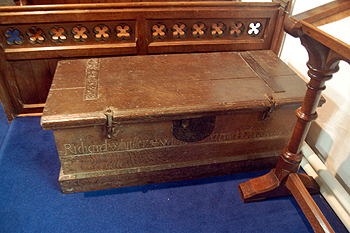
The parish chest June 2012
"A very fine church but it has suffered most grievously from the hands of beautifiers and restorers".
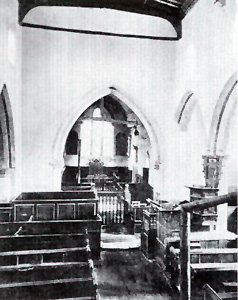
The interior looking east in 1874 from Horace Prescott's book
“The chancel roof is ceiled, and all around plastered, except where some wooden panelling has been introduced, painted in bad imitation of oak; this trumpery expedient has been adopted to conceal the ravages of damp, and will be found in a short time very inefficient to secure that object. The railings are carved in the worst taste, as well as the tablet over the altar. The chancel is of noble proportion, and although there are no pews, it was sad to observe other matters very offensive. The ledges of the woodwork formed a resting-place for tattered books and bags, indicating by these and the dirty appearance of the floor, that this quarter was appropriated to a Sunday-school. Under the words – “This do in remembrance of me” – was stretched a bench, turned upside-down; a long broom raked nearly half one side of the chancel, and, with the chimney-shaft of a stove, contributed to disfigure this quarter, which, as we have already observed, being of very excellent proportion, by proper attention might become what it was when fresh from the hands of the original builders – a very handsome example”.
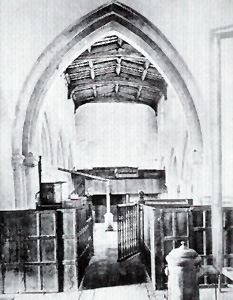
The interior looking west in 1874 from Horace Prescott's book
“The view from the nave into the chancel is obscured by two lofty square boxes assisted by a reading-desk of unnecessary height. The remains of the screen appear to have been used in forming exclusive sittings; a pulpit with a hideous sounding-board, a gallery, and a stove, evince the absence of care and taste that obtain in this church. Some miserable painting hides the arch of the chancel. The authors of this execrable trash have recorded their names on some lath-and-plaster work, completely shutting out the western window. Through this work is perforated a round hole, resembling that which adorns the showman’s box; its intent, we suppose, to enable the ringers to see when the minister has entered the desk. It is very flimsy, and a good push or two would put an end to this wretched affair, and the records of the names of those who ordered the “painting and beautifying of this church”. The nave and aisles have timber roofs”.
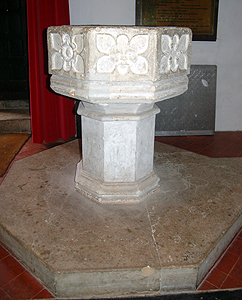
The font June 2012
“The font has a drain and leaden lining; but its use is superseded by a nondescript marble vase, which would be better in the rector’s [sic] garden, where, unhappily, too often are found some of the original fonts in our churches. An alms-box is to be found here”.
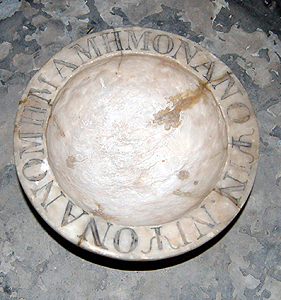
18th century bowl in the font June 2012
“The external roof of the chancel is of tiles, but the nave has a leaden covering. Though the churchyard is not locked up, we were informed a neighbouring farmer’s sheep are allowed to graze it. There is a very fine yew tree. No school”.
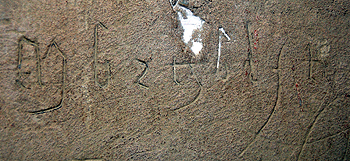
Graffito on a pillar in the south arcade June 2012
“It can hardly be expected that an ignorant peasantry will pay much attention or have much reverence for the condition of the church, while they remain in the neglected state this county exhibits. The recent report of the Council on Education states – “Every item connected with Bedfordshire seems to [be] influenced by the combination of remote ignorance with a profligate dependence of the men, in part, upon the earnings of the women and children; one half of the men at marriage being unable to write their names, and the proportion of crime 21 per cent above the average for all England on a population of like ages”. Such are the fatal results arising from an uninstructed people, filling our gaols, and loading the county and the rate-payers with expense. There is little doubt that great opposition is given to the instruction of the labourer by those whose purblind ignorance considers that education will render him less useful in his work. That such a feeling does exist in this county we have had practical proof. To such we beg the consideration of the following passage: - “Instruction not only makes labour intelligent and orderly, but creates new wants and desires, new activities, a love of employment, and an increased alacrity both of the body and the mind: and there is probably no example of a well-instructed population which is not also active and eager for work*””.

Graffiti in the tower June 2012
“For the rising generation the prospects are improving, but it might be well to consider whether something cannot be effected for the large class who have been permitted to attain manhood in a deporable state of ignorance, by rendering more available the purposes of evening instruction, now happily held out in so many instances. To render this effectual, some sacrifice, if this word must be used, is called for on the part of the employer, and we might mention a noble instance of this had we not, we fear, already trespassed too far on your indulgence; we beg, however, to conclude with the following beautiful extract from a speech which, though intended more for a manufacturing, is alike applicable to a rural population: - “In my opinion, it is the duty of the State to endeavour that you should have a population, in the first place, aware of the doctrines of religion; that in the next place, they should be able to cultivate domestic habits and [af]fections; and that, in the third place, they should be likely to look upon the laws and government of the country as their protectors from undue inflictions upon the young of this country. I do not see that these objects can be obtained so long as the hours of young persons are so prolonged as they have hitherto been. I cannot see how a girl of fourteen years of age, actually employed for twelve hours in a mill, and engaged then for two hours more, coming home tired and exhausted, and unable to so anything but rest – I say I do not understand how that girl can be brought up to be a good wife and a good mother+”.
“*Earl Grey. Letter on Minutes of the Council on Education, 1847, page 37; + Lord John Russell, Speech on the Factory Bill March 17 1847”.
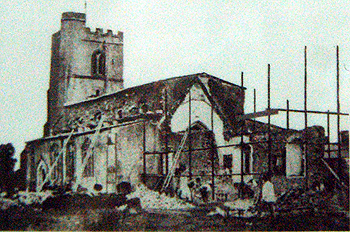
Caddington church under restoration in 1875
Prescott writes that when his father was appointed vicar in 1862 “he saw that the most urgent matter to require his attention was the condition of the fabric of the church … the natural deterioration of 450 years had to be overtaken and made good”. By 1875 enough money had been raised to begin restoration. It cost some £2,628 and was carried out under the supervision of the appropriately named Ewan Christian. The chancel was completely rebuilt at the expense of the holders of the advowson – the Ecclesiastical Commissioners (who had succeeded the Dean and Chapter of Saint Paul’s in 1872) and Mrs. Macnamara and cost £594. The entire fabric was restored and the church was re-seated. A vestry was added to the north side of the chancel, making the oculus in the north aisle blind.

Blind oculus at the east end of the north aisle June 2012
John Martin’s hated gallery was cleared away allowing in light from the west window and so too were the high pews Martin hated so cordially. The whitewash was stripped from the walls and replaced with red plaster. A new floor was laid in the church and the roof re-leaded and repaired. The font was moved and heating provided from two stoves beneath the floor. When removing the stove in the chancel the remains of John Hawtt and his wife, together with their commemorative brass, were removed nearer to the chancel steps.
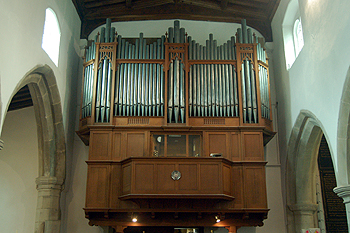
The organ June 2012
In 1912 a faculty was issued allowing the organ to be erected at the west end of the church [P35/2/2/3]. No doubt this caused John Martin to turn in his grave as the west window was, once more, obscured. In 1913 a faculty was issued for a stained glass window of “Christ blessing little children” by Moore & Son of London [P35/2/2/4]. The window is in the south aisle.
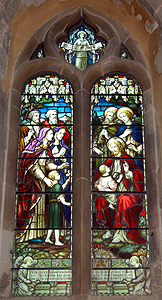
Stained glass window in the south aisle June 2012
In 1922 another faculty for a stained glass window was issued [P35/2/2/6]. This is in the north wall of the north aisle and is in memory of Ada Mary Prescott, Horace Montagu Prescott’s sister. It shows Faith, Hope and Charity.
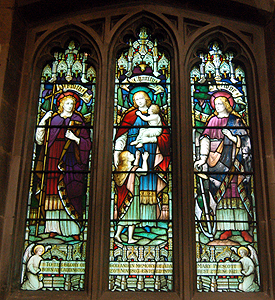
Stained glass window in the north aisle June 2012
By 1928 the roof was in need to repair. Investigations showed that it was infested by the larvae of a wood eating beetle. Accordingly £2,134 was spent on repairing it.

The nave roof June 2012
A credence table was installed in 1947 [P35/2/2/9]. In 1954 a faculty was issued to replace the under-floor hearing installed in 1875 with an oil-fired system. It cost £312 [P35/2/2/11].
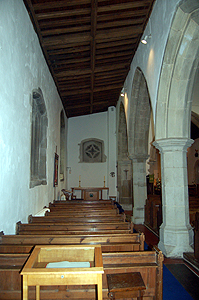
The north aisle looking east June 2012
In 1971 a faculty was issued for a Lady Chapel in the north aisle [P35/2/2/15]. An altar was installed and the flooring was altered. By the mid 1990s a number of repairs were necessary and a grant of £75,443 towards the cost was made by English Heritage [P35/2/2/20].
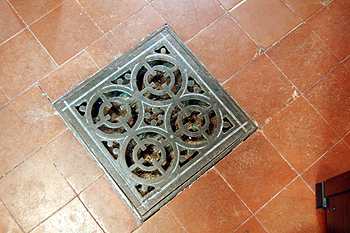
Vent for the former underfloor heating system June 2012